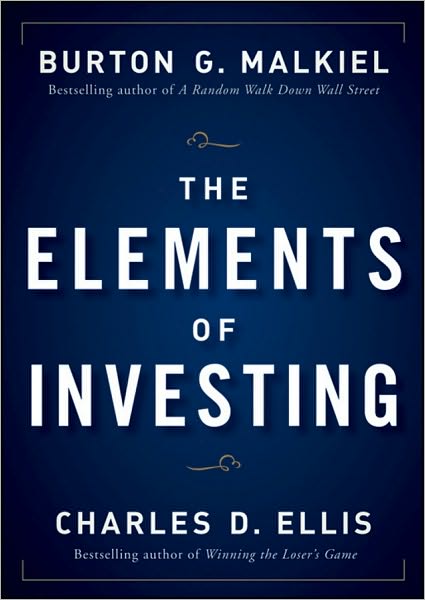This is a basic book.? A very, very basic book.? Did I mention this is a basic book?? Well, it is a basic book.
Sorry about that.? When you read a lot of sophisticated stuff on investing regularly, and then read The Elements of Investing, you know that you have to take a step back and re-think investing for everyone.
Written by Burton G. Malkiel & Charles D. Ellis, two notable investment writers favoring low cost indexing, and with a forward from David Swensen, you know that it will be a traditional buy-and-hold analysis.? (Though there is something funny here.? The authors criticize using the complex asset classes that Swensen uses, and Swensen criticizes buying individual stocks, which the authors use in small measure.)
The book has five sections:
- Saving
- Indexing
- Diversify
- Avoid Blunders
- Keep it Simple
The section on saving is excellent, and offers many ways that people can cut their spending without ruining their lives.
The indexing section is fine, though it overstates the inability of investors to beat the indexes.? Yes, the market can’t beat the market as a whole, but dedicated investors following value and momentum can beat the market, until too many copy those unpopular strategies.
Diversification is wise.? But there are limits.? If one is going to be active, be active, and ignore the index.? Otherwise, be passive and index.? What’s that, you say: “If I miss by too much, I will lose a lot of assets.”? Sorry, but that is the price of being an active manager.? If you are going to do it make the most of it; don’t hug the index.? But the wag will say, “just avoid being in the bottom quartile.? You only get fired in the bottom quartile, so hug the index.”? The behaviors that benefit managers are not the same ones that benefit clients.
They recommend rebalancing, which I do as well.? They also recommend value investing in moderation.
I am totally in agreement with the chapter on avoiding blunders.? You win by not losing, and compound it over time to really build value.
The section on keeping it simple focuses on asset allocation, tailoring investment returns to individual situations, and is pretty basic.? I found little objectionable here, but I would spend some time analyzing when asset classes are cheap or dear.
They have an appendix on saving on taxes which is valuable, but if I had been in their shoes, I would have described additional strategies to lower tax liabilities off of both capital gains and losses.
Quibbles
They treat international investing as a free lunch, which it is not due to confiscation, currency risks, war, plague, famine, financial failure, etc.? The last forty years have been special, because of peace in developed economies.? That may not be true in the future.? I invest internationally, but only 25% of assets at most, and only in places where I trust the rule of law.
Who would benefit from these books:
This is the perfect book for your dumb brother-in-law (or similar) who has excess cash flow, and always seems to lose money on his investments.? Given the section on saving, it could also be valuable for your spendthrift brother who is constantly complaining about being in debt.
This is a very basic book.? Give it to the clueless; it cetainly won’t hurt them, and it might help them a lot.
If you want to, you can buy it here:?The Elements of Investing.
Full disclosure: Without asking, I was e-mailed a copy of the book.? Personally, if I were the publisher, I would send a physical copy.? Not that I am going to post it for free use, but I know that many will.
If you enter Amazon through my site, and you buy anything, I get a small commission.? This is my main source of blog revenue.? I prefer this to a ?tip jar? because I want you to get something you want, rather than merely giving me a tip.? Book reviews take time, particularly with the reading, which most book reviewers don?t do in full, and I typically do. (When I don?t, I mention that I scanned the book.? Also, I never use the data that the PR flacks send out.)
Most people buying at Amazon do not enter via a referring website.? Thus Amazon builds an extra 1-3% into the prices to all buyers to compensate for the commissions given to the minority that come through referring sites.? Whether you buy at Amazon directly or enter via my site, your prices don?t change.


David, what would you think of this book as a basis for teaching high school age kids about investing? Might there be another book better suited for this?
There are so many areas to teach in investing. For money managment, I would consider “Easy Money,” which I have reviewed. This could be a good book, but so could just reading Ben Graham’s “The Intelligent Investor,” or Buffett’s annual reports.